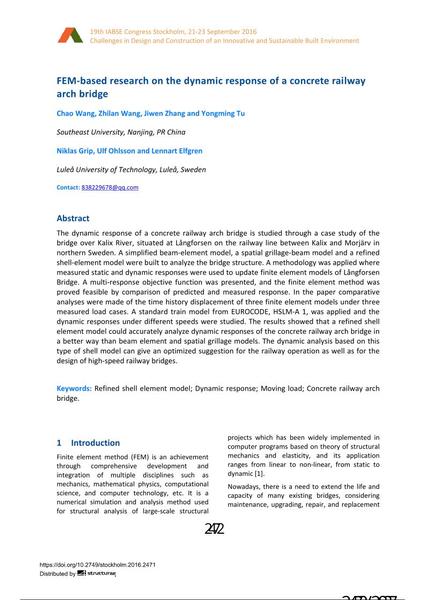FEM-based research on the dynamic response of a concrete railway arch bridge

|
|
|||||||||||
Bibliografische Angaben
| Autor(en): |
Chao Wang
(Southeast University, Nanjing, PR China)
Zhilan Wang (Southeast University, Nanjing, PR China) Jiwen Zhang (Southeast University, Nanjing, PR China) Yongming Tu (Southeast University, Nanjing, PR China) Niklas Grip (Luleå University of Technology, Luleå, Sweden) Ulf Ohlsson (Luleå University of Technology, Luleå, Sweden) Lennart Elfgren |
||||
|---|---|---|---|---|---|
| Medium: | Tagungsbeitrag | ||||
| Sprache(n): | Englisch | ||||
| Tagung: | IABSE Congress: Challenges in Design and Construction of an Innovative and Sustainable Built Environment, Stockholm, Sweden, 21-23 September 2016 | ||||
| Veröffentlicht in: | IABSE Congress Stockholm, 2016 | ||||
|
|||||
| Seite(n): | 2472-2479 | ||||
| Anzahl der Seiten (im PDF): | 8 | ||||
| Jahr: | 2016 | ||||
| DOI: | 10.2749/stockholm.2016.2471 | ||||
| Abstrakt: |
The dynamic response of a concrete railway arch bridge is studied through a case study of the bridge over Kalix River, situated at Långforsen on the railway line between Kalix and Morjärv in northern Sweden. A simplified beam-element model, a spatial grillage-beam model and a refined shell-element model were built to analyze the bridge structure. A methodology was applied where measured static and dynamic responses were used to update finite element models of Långforsen Bridge. A multi-response objective function was presented, and the finite element method was proved feasible by comparison of predicted and measured response. In the paper comparative analyses were made of the time history displacement of three finite element models under three measured load cases. A standard train model from EUROCODE, HSLM-A 1, was applied and the dynamic responses under different speeds were studied. The results showed that a refined shell element model could accurately analyze dynamic responses of the concrete railway arch bridge in a better way than beam element and spatial grillage models. The dynamic analysis based on this type of shell model can give an optimized suggestion for the railway operation as well as for the design of high-speed railway bridges. |
||||
